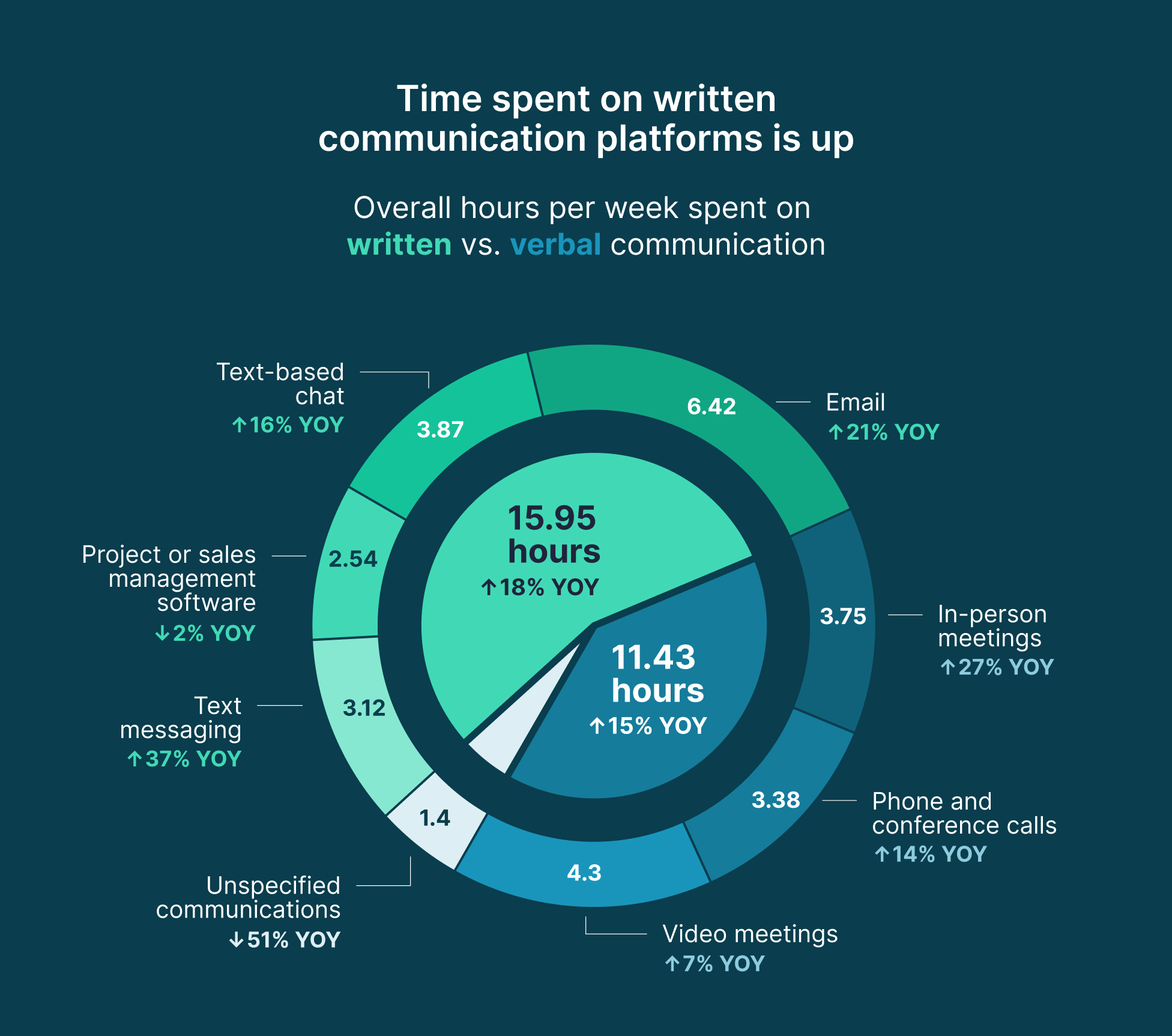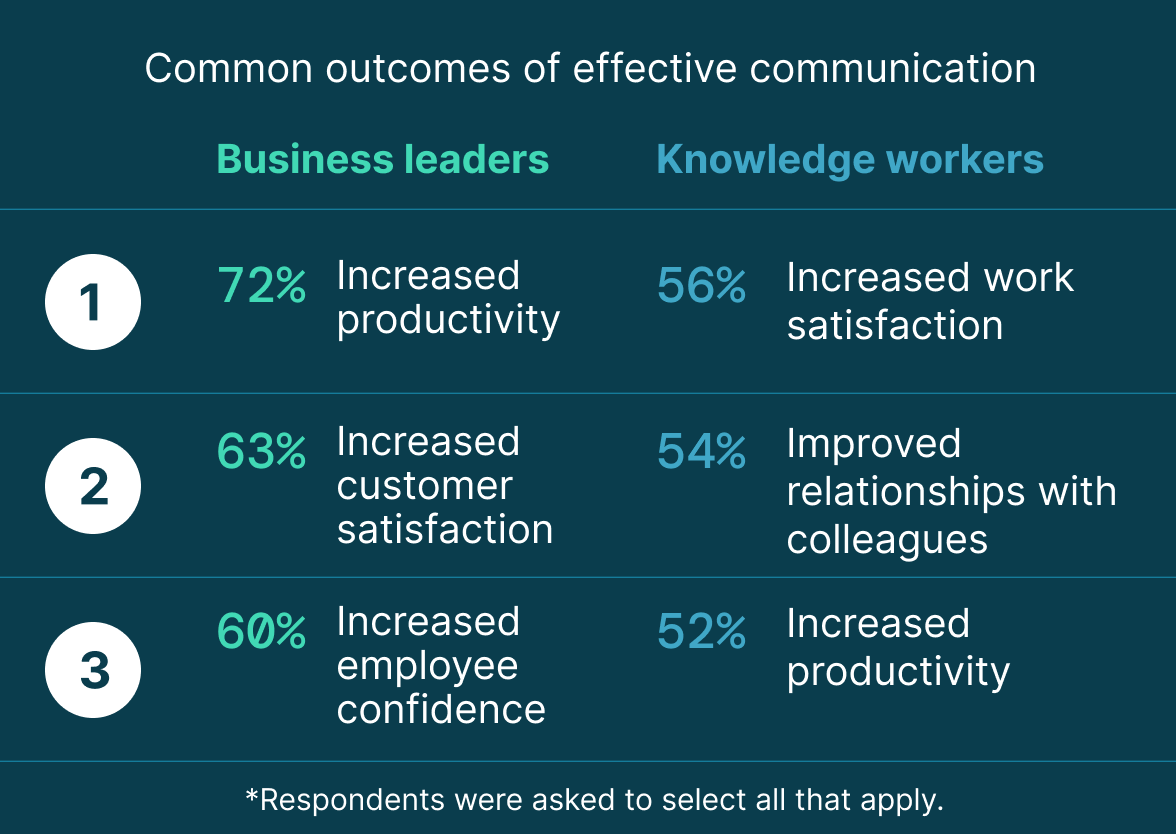It’s now a year after our initial inquiry into the state of business communications, and we’re still reeling from finding out that poor communication costs US businesses an estimated $1.2 trillion annually or $12,506 per employee per year. So when we partnered with The Harris Poll to create this year’s State of Business Communication survey, naturally we were eager to see what’s changed.
This year, the data shows us that the problem hasn’t gotten better and, in fact, is only growing more complex.
You’ve probably felt the repercussions in your inbox by now, but organizations are communicating more than ever before, and the quality and effectiveness of that communication are declining. Knowledge workers are spending more time communicating than last year—up by 9% year-over-year (YOY)—but business leaders report that the effectiveness of that communication has waned by 12%.
The short version of this story is that organizations are spending more time on a core function and doing it poorly. As a result, the business impacts of poor communication are being compounded. Here are three key findings from the report that leaders must consider as they search for a competitive edge and strive to achieve their full potential.
1. Written and asynchronous communication are rising in importance
Data from this year’s report shows that asynchronous communication is on the rise, with 72% of knowledge workers reporting that they are communicating more asynchronously than they did last year. Asynchronous communication is distinguished by interactions that do not take place in real time or do not require an immediate response.
Alongside a rise in asynchronous work, the data also shows a rise in written communication. This is natural because knowledge workers communicate more in a written format to exchange information on platforms that support asynchronous collaboration, such as email and text-based chat. Data from this year’s report shows that time spent on written communication channels has increased by 18% since last year.

2. Effective written communication is essential for driving productivity and performance
Organizations are communicating more in written form, but data from this year’s report shows that the overall effectiveness of that communication is waning, with serious implications for the business. Business leaders report a 12% drop in the effectiveness of written communication year-over-year and “decreased productivity” (+15% YoY) due to poor communication.
The report offers clues about why knowledge workers are struggling to communicate in written form. These are the most salient challenges knowledge workers face when collaborating with colleagues on text-based channels:
- Choosing the right words to avoid offending others (71%)
- Finding the appropriate balance between sounding too formal and too casual (71%)
- Spending too much time trying to convey a message in the right way (63%)
When knowledge workers struggle to communicate well, the business suffers from the resulting “swirl” of misinformation, lack of alignment, and tedious rework. When 80% of knowledge workers and 93% of business leaders say their ability to get work done is strongly contingent on how well their collaborators communicate their needs or share their ideas, getting written communication right becomes a business imperative.
The proof is also in the data: Leaders report increased productivity (72%), increased customer satisfaction (63%), and increased employee confidence (60%) as the top three benefits of effective communication.

3. Communication is a core function that affects everyone within the organization
It’s not all doom and gloom. Data from this year’s report also offers hope for what’s possible when leaders prioritize communication. Investing in people’s ability to communicate well imbues confidence and efficiency into everyday work. Here’s some of the data that shows what’s possible.
- Confident communicators are more productive and engaged at work. Knowledge workers who are confident in their written communication skills are more likely to feel confident in their work (7.8/10 versus 6.2/10), feel engaged in their role (7.8/10 versus 6.5/10), and rate their mental well-being at work higher (7.2/10 versus 5.7/10).
- Knowledge workers can adjust their tone to craft more effective messages. When the sender of a message uses a positive tone, knowledge workers report that they are more likely to respond quickly to the message (62%), have an improved perception of the sender (59%), and address the concern or do the work at a higher quality (48%).
- Effective communication improves intra-organizational relationships to drive overall efficiency. Knowledge workers report that effective communication improves both job satisfaction (56%) and relationships with colleagues (54%). As noted earlier, the majority of both knowledge workers and business leaders also agree that their ability to get work done is strongly contingent on how well collaborators can express their needs.
How will you empower effective communication?
When it comes to improving communication, many leaders might think of platforms first. It’s a good instinct, but data from this year’s report shows us that it’s not just what and where we communicate that matters, but also how we communicate.
The data shows that leaders often fixate on platforms or pathways for communication, but knowledge workers actually need help with tone and the quality of communication. In fact, when asked to identify important elements of communication, 66% of business leaders selected platforms while only 36% of knowledge workers agreed. Meanwhile, the majority of knowledge workers (54%) identified tone as an important element of communication.
Leaders must offer tools to help knowledge workers be more effective where they communicate and have more confidence and control over the tone and quality of the messages they send.
To discover more findings from this year’s State of Business Communications report, download the full report.



